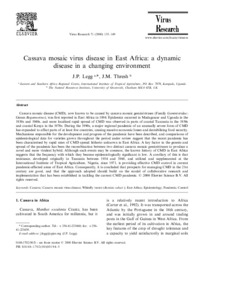| dc.contributor.author | Legg, J.P. |
| dc.contributor.author | Thresh, J. |
| dc.date.accessioned | 2019-12-04T11:21:06Z |
| dc.date.available | 2019-12-04T11:21:06Z |
| dc.date.issued | 2000 |
| dc.identifier.citation | Legg, J. & Thresh, J. (2000). Cassava mosaic virus disease in East Africa: a dynamic disease in a changing environment. Virus Research, 71, 135-149. |
| dc.identifier.issn | 0168-1702 |
| dc.identifier.uri | https://hdl.handle.net/20.500.12478/3667 |
| dc.description.abstract | Cassava mosaic disease (CMD), now known to be caused by cassava mosaic geminiviruses (Family Geminiviridae; Genus Begomovirus), was first reported in East Africa in 1894. Epidemics occurred in Madagascar and Uganda in the 1930s and 1940s, and more localised rapid spread of CMD was observed in parts of coastal Tanzania in the 1930s and coastal Kenya in the 1970s. During the 1990s, a major regional pandemic of an unusually severe form of CMD has expanded to affect parts of at least five countries, causing massive economic losses and destabilising food security. Mechanisms responsible for the development and progress of the pandemic have been described, and comparisons of epidemiological data for varieties grown throughout the period under review suggest that the recent pandemic has been characterised by rapid rates of CMD spread hitherto unknown in East Africa. A key factor in the genesis and spread of the pandemic has been the recombination between two distinct cassava mosaic geminiviruses to produce a novel and more virulent hybrid. Although such events may be common, the known history of CMD in East Africa suggests that the frequency with which they become epidemiologically significant is low. A corollary of this is that resistance, developed originally in Tanzania between 1934 and 1960, and utilized and supplemented at the International Institute of Tropical Agriculture, Nigeria, since 1971, is providing effective CMD control in current pandemic-affected areas of East Africa. Consequently, it is concluded that prospects for managing CMD in the 21st century are good, and that the approach adopted should build on the model of collaborative research and implementation that has been established in tackling the current CMD pandemic. |
| dc.language.iso | en |
| dc.subject | Cassava |
| dc.subject | Cassava Mosaic |
| dc.subject | Virus Disease |
| dc.subject | Whitefly Vector |
| dc.subject | Epidemiology |
| dc.subject | Pandemic |
| dc.subject | Control |
| dc.title | Cassava mosaic virus disease in East Africa: a dynamic disease in a changing environment |
| dc.type | Journal Article |
| dc.description.version | Peer Review |
| cg.contributor.affiliation | International Institute of Tropical Agriculture |
| cg.contributor.affiliation | University of Greenwich |
| cg.coverage.region | Africa |
| cg.coverage.region | Acp |
| cg.coverage.region | East Africa |
| cg.coverage.region | Europe |
| cg.coverage.country | Uganda |
| cg.coverage.country | United Kingdom |
| cg.isijournal | ISI Journal |
| cg.authorship.types | CGIAR and advanced research institute |
| cg.iitasubject | Cassava |
| cg.iitasubject | Diseases Control |
| cg.iitasubject | Pests Of Plant |
| cg.iitasubject | Plant Breeding |
| cg.iitasubject | Plant Production |
| cg.iitasubject | Plant Diseases |
| cg.iitasubject | Handling, Transport, Storage And Protection Of Agricultural Products |
| cg.iitasubject | Farm Management |
| cg.iitasubject | Livelihoods |
| cg.accessibilitystatus | Limited Access |
| local.dspaceid | 95822 |
| cg.identifier.doi | https://doi.org/10.1016/S0168-1702(00)00194-5 |

